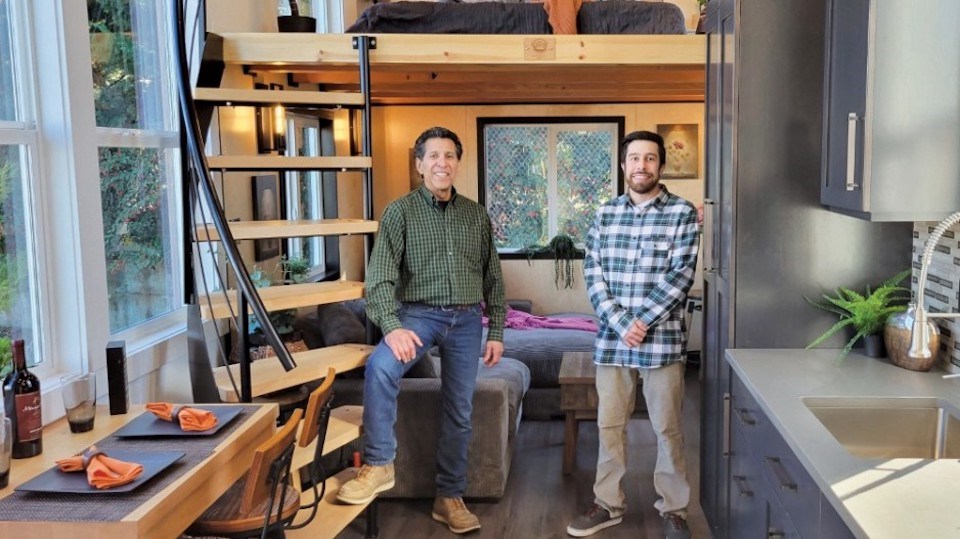Could living in a tiny mobile home that is so customized and intricate that the final product more closely resembles a high-end custom house be a solution to the Lower Mainland’s lack of affordable housing stock?
The trend of tiny houses built on wheels and offering between 200 and 400 square feet of dwelling space has been increasingly popular in other North American jurisdictions like California, Washington and Hawaii. These markets, while different from Metro Vancouver, share the B.C. market’s high prices, lack of affordability and limited housing stock.
One such builder, Oregon-based Tiny Mountain Houses, started its modular factory-constructed housing business in 2014. But according to company principal Lou Pereyra, most orders he receives today are higher-end custom homes on wheels that customers can park to add permanent housing capacity to their properties.
“Generally, the highest demand is in high-rent districts,” Pereyra said. “It could be in bigger cities where upwards of $3,000 a month gets you almost nothing, and we see a lot of migration towards something different. Hawaii is a big market for us, Seattle, Portland, the Bay Area … where some people just stick it in their backyards where the local codes permit tiny houses.”
The key, he said, is that the product’s effectiveness is tied to land availability. Accordingly, Pereyra noted, most sales have gone to rural or suburban communities – although he added that some urban markets have been receptive to tiny homes, too.
He said there have been inquiries from Canadian customers – although most of his sales still originate from the U.S.
A veteran Canadian affordable housing researcher said the tiny homes are likely to run into challenges in major urban cities in Canada due to local zoning laws and vehicle regulations, but added that the concept shows an innovative way for Canadians to resolve the country’s worsening housing affordability crisis.
Avi Friedman, professor of architecture at McGill University in Montreal and an expert on housing affordability and sustainability in Canada, said the idea of tiny houses isn’t fundamentally different from the idea of laneway houses. Both seek to expand the residential capacity of a finite parcel of land – something that is crucial to dealing with the housing issue in B.C., Friedman said.
However, the challenge in adding home-on-wheels capacity to residential properties in urban areas such as Vancouver will lie in persuading urban municipal governments and neighbours to accept the added density as well as the additional stresses on local infrastructure. Friedman said that most urban governments like those in Vancouver and nearby cities will not likely support the home-on-wheels option.
“Don’t misunderstand me; I like this solution,” he said. “I don’t think everyone should be living in McMansions. Young people can live comfortably in a tiny home, and some products are very innovative.
“Unfortunately, to convince big cities to allow this is difficult. It may not be impossible – someone may have to challenge zoning in court – but you will not get a permit to place [tiny houses] onto your property.”
The biggest barrier, as it often is in situations like this, is money. While city planners will also cite concerns about the ability of a home-on-wheels to fit into the character of a neighbourhood, the primary obstacle is tax revenue – or the lack thereof.
“Cities make money on taxes,” Friedman said. “And they don’t want these type of structures because there’s no [property tax] revenue in them. You need to connect these structures to sewers, power and water, and the need to access these things makes such a product in an established urban environment quite a challenge.”
Vancouver’s city bylaw currently prohibits the use of tents, tent-trailers, vans and RVs for residential uses. Mobile homes are allowed only in mobile home parks, according to the municipality, and putting a mobile home on one’s property is also outlawed within Vancouver city limits.
However, peripheral and rural areas have their own local zoning laws and may allow an owner to park a tiny house on property for residential use, Friedman said. That is why, he noted, that these products – before any changes in urban zoning bylaws – may be best suited for suburbs with more relaxed bylaws or rural areas with housing-stock issues. Places like the Okanagan, for example, may benefit fairly quickly from such an idea.
Friedman also noted that other B.C. municipalities have shown a willingness to try new ways to boost housing capacity.
Langford, in the Greater Victoria region, has for example allowed apartments to be built over two-car garages – something that can achieve densification goals similar to that of tiny houses. (Friedman is scheduled to speak at a March 5 online event about planning the future of Langford’s downtown.)
“The point is, in order to achieve affordability, the land needs to be better utilized,” Friedman said. “On the same lot, you need to do more than just build one building.”
Pereyra said he is confident that there is a market for the homes that Tiny Mountain builds.
He also agrees that the biggest challenge is zoning bylaws in each municipality, but noted he has seen municipalities in jurisdictions like California beginning to relax their attitudes about new concepts when dealing with the housing crisis.
“The issue is the building department in these cities, more often than not.”
Pereyra added that some customers want a tiny house so badly that they simply make the purchase and unilaterally place them on their property – without checking for any violations of municipal laws.
“People are looking for something not temporary, something they can live in for a long time,” Pereyra said.
“I think their key concern is taxation. But people want places to live that are also affordable; this fits their needs. We have rural buyers, but we also have buyers with established properties who are buying to house their kids or relatives. The demand is widespread.”




